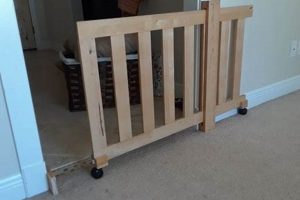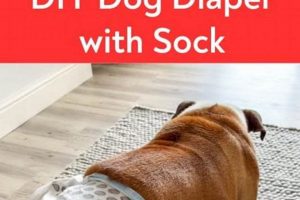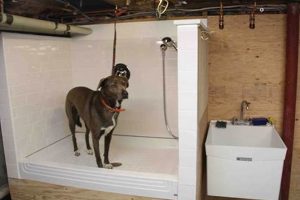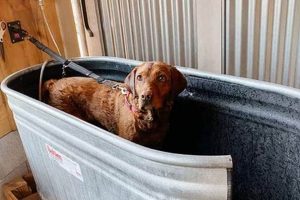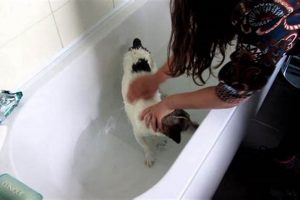Footwear created at home for canine companions serves a protective function. These coverings shield paws from environmental hazards such as extreme temperatures, rough terrains, and abrasive substances. An example includes constructing a simple bootie from repurposed fabric to safeguard a dog’s feet during winter walks.
The construction of custom paw protection offers several advantages. It allows for tailored fit, accommodating unique paw shapes and sizes that may be difficult to find in commercially available options. Furthermore, this approach can be more economical, utilizing readily available materials and reducing expenditure on pet supplies. Historically, resourceful owners have crafted such items to address specific needs and protect working dogs.
The following discussion will explore methods for constructing durable paw coverings, detailing material selection considerations, and providing guidance on ensuring proper fit and comfort for the animal.
Tips for Constructing Canine Paw Protection
The following guidelines offer practical advice for creating effective and comfortable paw coverings for dogs. Attention to detail and material selection are crucial for ensuring the safety and well-being of the animal.
Tip 1: Material Selection. Opt for durable, water-resistant materials that provide insulation without compromising breathability. Canvas, fleece, and neoprene are suitable choices. Avoid materials that may cause irritation or contain toxic substances.
Tip 2: Accurate Paw Measurement. Precise measurements are essential for a proper fit. Measure the length and width of the paw while the dog is standing, adding a small allowance for movement. Consider the breed and potential growth, if applicable.
Tip 3: Secure Fastening System. Implement a secure and adjustable fastening system to prevent the coverings from slipping off during activity. Velcro straps, elastic bands, or drawstrings can be incorporated, ensuring they do not constrict circulation.
Tip 4: Durable Sole Construction. Reinforce the sole with a non-slip material to provide traction and protect against abrasion. Rubber or textured fabric can be applied to the bottom of the covering using adhesive or stitching.
Tip 5: Gradual Introduction. Acclimatize the dog to the paw coverings gradually. Begin with short periods of wear indoors, rewarding positive behavior. Gradually increase the duration and introduce outdoor environments.
Tip 6: Regular Inspection and Maintenance. Routinely inspect the coverings for wear and tear. Repair any damages promptly to prevent injuries. Clean the coverings regularly to maintain hygiene and prevent infections.
Tip 7: Consider Environmental Conditions. Adapt the design and materials to the specific environmental conditions. For snowy conditions, consider using waterproof materials and adding extra insulation. For hot pavement, opt for breathable materials that reflect heat.
The careful consideration of material selection, accurate sizing, and secure fastening mechanisms contributes to the creation of functional and comfortable paw coverings. Regular inspection and acclimatization are also essential for optimal use and canine well-being.
The subsequent sections will delve into specific design variations and advanced construction techniques for creating specialized paw protection.
1. Material Durability
The selection of robust materials constitutes a foundational element in the successful creation of canine paw coverings. Inherent to “diy shoes for dogs” is the consideration of the forces exerted upon the footwear during various activities. Insufficient material strength precipitates premature failure, rendering the protective device ineffective. For instance, utilizing thin, easily torn fabric for the sole of a paw covering intended for use on abrasive surfaces, such as concrete or gravel, will inevitably result in rapid degradation and potential injury to the animal’s paws. The causal relationship is direct: inadequate material durability leads to compromised protection and decreased longevity of the homemade product.
The importance of material durability is amplified by the diverse environmental conditions in which canine footwear may be deployed. Exposure to moisture, extreme temperatures, and rough terrain necessitates the use of resilient materials capable of withstanding these stressors. An illustrative example involves the creation of paw coverings for dogs engaged in winter activities. In such cases, materials such as waterproof canvas or durable neoprene are preferred due to their resistance to moisture penetration and abrasion from ice and snow. Failure to select materials with these properties can result in discomfort, frostbite, or injury to the dog’s paws.
In summary, material durability is an indispensable component of canine paw coverings. The long-term effectiveness and protective capacity of “diy shoes for dogs” are directly contingent upon the selection of materials capable of withstanding the intended use conditions. Challenges inherent in this process include balancing material strength with flexibility and comfort. A thorough understanding of material properties and anticipated environmental stressors is crucial for the successful construction of durable and effective canine paw protection.
2. Accurate Sizing
Accurate sizing constitutes a critical determinant of the efficacy and comfort of homemade canine paw protection. The precision with which these coverings conform to the dimensions of the dog’s paws directly impacts their ability to provide adequate protection and maintain secure placement during activity.
- Paw Dimensions and Mobility
Accurate sizing requires precise measurement of both the length and width of the dog’s paw while weight-bearing. Insufficient allowance for natural paw splay during movement results in constriction, impeding circulation and potentially causing discomfort or injury. Conversely, excessive room leads to slippage, diminishing protection and increasing the risk of the covering being dislodged. An ideal fit permits unrestricted movement while maintaining a snug, secure contact.
- Breed-Specific Considerations
Canine breeds exhibit significant variations in paw morphology. Sizing protocols must account for these differences. For instance, breeds with wider paws necessitate a design that accommodates this feature, while breeds with dewclaws require consideration to avoid irritation or obstruction. Ignoring these breed-specific nuances can lead to ill-fitting coverings that fail to provide adequate protection.
- Material Elasticity and Tolerance
The elasticity of the chosen material must be factored into the sizing process. Inelastic materials demand more precise measurements, whereas elastic materials allow for slightly greater leniency. However, excessive elasticity can compromise support and increase the likelihood of slippage. Furthermore, manufacturing tolerances must be considered, as slight variations in material dimensions can accumulate and impact the final fit.
- Gait and Activity Level
Sizing adjustments may be necessary based on the dog’s gait and activity level. Dogs engaged in high-impact activities may require a more secure fit to prevent dislodgement, while dogs with an unusual gait may benefit from a design that accommodates their specific movement patterns. Observing the dog’s gait while measuring the paw can provide valuable insights for optimizing the fit of the covering.
The implications of accurate sizing extend beyond mere comfort. Properly fitted “diy shoes for dogs” minimize the risk of chafing, pressure sores, and impaired circulation, promoting long-term paw health. The synergy between precise measurements, breed-specific considerations, material properties, and activity-level adjustments is essential for achieving optimal fit and maximizing the protective benefits of homemade canine paw coverings.
3. Secure Fastening
The integrity of homemade canine paw protection hinges significantly on the effectiveness of its fastening mechanism. Without a secure and reliable system, the coverings are prone to slippage and detachment, rendering them functionally useless and potentially hazardous to the animal. Therefore, the design and implementation of a secure fastening system are paramount in the successful creation of “diy shoes for dogs”.
- Adjustability and Customization
An ideal fastening system allows for adjustability to accommodate variations in paw size and shape, as well as changes in paw dimensions due to swelling or environmental conditions. Customization options, such as interchangeable straps or adjustable closures, enhance the adaptability of the covering to individual canine needs. For example, a system employing multiple Velcro straps offers superior adjustability compared to a single fixed strap, allowing for a more precise and comfortable fit.
- Durability and Resistance to Wear
The materials used in the fastening system must exhibit sufficient durability to withstand the stresses associated with canine activity. Components such as buckles, straps, and closures should be resistant to abrasion, tearing, and environmental degradation. The stitching connecting the fastening system to the paw covering must be reinforced to prevent separation under stress. Inferior materials or weak stitching compromise the integrity of the fastening system, leading to premature failure and loss of paw protection.
- Ergonomics and Ease of Use
A well-designed fastening system should be easy to apply and remove without causing discomfort or distress to the animal. Complex or cumbersome designs may discourage owners from using the coverings consistently. Ergonomic considerations, such as the placement and orientation of closures, contribute to the user-friendliness of the system. A fastening system that can be quickly and easily secured with one hand is advantageous, particularly for owners with limited dexterity.
- Safety and Non-Constriction
The fastening system must be designed to avoid constriction of circulation or irritation to the dog’s skin. Straps and closures should be positioned to distribute pressure evenly and prevent localized binding. Sharp edges or abrasive surfaces should be avoided to minimize the risk of chafing or injury. Regular monitoring of the dog’s paws is essential to detect any signs of irritation or discomfort caused by the fastening system. A system that allows for unrestricted movement and maintains consistent circulation is essential for long-term canine comfort and well-being.
In conclusion, the effectiveness of “diy shoes for dogs” is inextricably linked to the design and implementation of a secure and reliable fastening system. By prioritizing adjustability, durability, ergonomics, and safety, creators can ensure that their homemade paw coverings provide optimal protection and comfort for their canine companions. The iterative refinement of fastening systems, based on user feedback and real-world performance data, is crucial for advancing the functionality and practicality of canine paw protection.
4. Sole Traction
Sole traction is a critical design element in homemade canine paw coverings. The coefficient of friction exhibited by the sole material directly influences the dog’s stability and maneuverability on various surfaces. Inadequate traction results in increased risk of slips, falls, and subsequent injuries, especially on slick or uneven terrain. Therefore, the selection and implementation of appropriate sole materials is paramount to the safety and effectiveness of “diy shoes for dogs”. An example illustrating this principle involves paw coverings intended for use on ice or snow. Smooth-soled coverings offer negligible grip, increasing the likelihood of falls. Conversely, coverings with textured rubber soles, or those incorporating small cleats, provide enhanced traction, mitigating the risk of slippage.
The relationship between sole traction and canine safety extends beyond preventing acute injuries. Consistent lack of traction can lead to compensatory gait adjustments, resulting in chronic musculoskeletal strain. For example, a dog repeatedly slipping on a smooth surface may alter its stride to maintain balance, placing undue stress on joints and muscles. The long-term consequences of such adaptations can include arthritis, lameness, and reduced mobility. To mitigate these risks, individuals crafting paw coverings must carefully consider the intended use environment and select sole materials that provide adequate grip without compromising flexibility or comfort. Materials commonly employed to enhance traction include textured rubber, silicone, and non-slip fabrics, often adhered to the base material using industrial adhesives or reinforced stitching.
In summary, sole traction is not merely an ancillary feature but a fundamental component of safe and functional “diy shoes for dogs”. Its influence extends from preventing immediate injuries to mitigating long-term musculoskeletal issues. Understanding the correlation between sole material properties, environmental conditions, and canine biomechanics is crucial for creating paw coverings that effectively protect and support the animal. Challenges in this regard involve balancing traction with durability, flexibility, and cost-effectiveness. However, the ethical imperative to prioritize canine safety necessitates a diligent and informed approach to sole material selection.
5. Weather Resistance
Weather resistance is a crucial attribute in canine paw protection, particularly when considering homemade options. The ability of “diy shoes for dogs” to withstand environmental elements significantly impacts their functionality and the well-being of the animal. Without adequate weather resistance, these coverings may fail to provide sufficient protection from moisture, cold, or heat, potentially leading to discomfort, injury, or illness.
- Waterproof Materials and Construction
The selection of waterproof materials is essential for preventing moisture penetration into the paw covering. Fabrics such as waterproof canvas, coated nylon, or neoprene offer varying degrees of water resistance. Equally important is the construction method. Seams must be sealed or reinforced to prevent water from seeping through stitching holes. Failure to achieve waterproof integrity can result in damp paws, increasing the risk of frostbite in cold weather and promoting the growth of bacteria or fungi in warmer conditions.
- Thermal Insulation and Heat Reflection
Effective weather resistance includes both insulation against cold temperatures and reflection of heat from hot surfaces. Insulating materials, such as fleece or synthetic batting, trap air to reduce heat loss from the paws. For protection against hot pavement, light-colored or reflective materials can minimize heat absorption. A lack of thermal protection can lead to frostbite in freezing conditions or burns from hot surfaces, emphasizing the need for appropriate material selection based on anticipated environmental conditions.
- Wind Resistance and Breathability
While waterproof materials protect against moisture, wind-resistant fabrics shield against the convective heat loss caused by wind. However, it’s essential to balance wind resistance with breathability. Materials that completely block airflow can trap moisture and lead to overheating or skin irritation. Breathable membranes or fabrics allow moisture vapor to escape, maintaining a comfortable environment for the paw. Prioritizing breathability while maintaining wind resistance is crucial for all-weather comfort.
- UV Protection and Material Degradation
Prolonged exposure to ultraviolet (UV) radiation can degrade materials, compromising their weather resistance and overall durability. Certain fabrics are inherently more resistant to UV damage, while others can be treated with UV-protective coatings. Regular inspection and maintenance are necessary to identify and address any signs of material degradation caused by UV exposure. Neglecting UV protection can lead to premature failure of the paw coverings, reducing their lifespan and effectiveness.
The facets of waterproof construction, thermal insulation, wind resistance with breathability, and UV protection collectively determine the weather resistance of “diy shoes for dogs”. Understanding these factors and selecting appropriate materials and construction techniques is paramount for creating paw coverings that effectively protect canine companions in diverse environmental conditions. The ethical responsibility of providing adequate protection necessitates a careful consideration of weather-related challenges and a commitment to crafting durable and weather-resistant paw coverings.
6. Comfort
The relationship between comfort and canine paw coverings is paramount, directly impacting the animal’s acceptance and willingness to wear such devices. “diy shoes for dogs,” if poorly designed with regard to comfort, may cause chafing, pressure sores, or restricted circulation, leading to distress and rejection of the footwear. For example, a boot constructed from stiff, inflexible material can rub against the dog’s paw, creating friction and potentially open wounds, thereby negating any protective benefits. The cause-and-effect relationship is clear: discomfort precipitates non-compliance, undermining the intended purpose of the paw covering. Therefore, comfort serves as a critical component influencing the overall success and utility of homemade paw protection.
Design aspects that significantly impact comfort include material selection, fit, and breathability. Soft, pliable materials such as fleece or padded fabrics minimize friction and pressure points. Proper fit, achieved through accurate measurements and adjustable closures, ensures that the covering remains securely in place without constricting movement or circulation. Breathable materials, such as mesh or moisture-wicking fabrics, prevent the accumulation of sweat and moisture, reducing the risk of skin irritation and maintaining a comfortable microclimate within the boot. Addressing these factors allows for the creation of paw coverings that the dog tolerates, leading to increased usage and improved paw protection during outdoor activities. Consider a scenario where a dog refuses to wear commercially available boots due to a rigid design. A custom-made boot utilizing soft, flexible materials and a precise fit addresses the comfort issue, resulting in successful paw protection during walks on hot pavement or icy surfaces.
The practical significance of prioritizing comfort in “diy shoes for dogs” extends to the animal’s long-term well-being. Comfortable paw coverings promote acceptance and regular use, enabling consistent protection from environmental hazards. While creating such items presents challenges, including balancing durability with softness and accommodating unique paw shapes, the effort invested in ensuring comfort directly correlates with the effectiveness of the paw coverings and the health of the animal’s paws. In conclusion, comfort is an indispensable design consideration, influencing acceptance, promoting consistent use, and contributing to the overall health and well-being of the canine companion.
Frequently Asked Questions
The following addresses common inquiries regarding the creation and utilization of homemade paw coverings for dogs. The information presented aims to provide clarity and guidance for individuals seeking to protect their canine companions’ paws.
Question 1: Are homemade paw coverings as effective as commercially available options?
The efficacy of homemade paw coverings depends heavily on the materials used, construction techniques, and accuracy of fit. Properly constructed, coverings can offer comparable protection to commercial products. However, quality control rests solely with the individual creator, necessitating diligent attention to detail.
Question 2: What materials are most suitable for constructing “diy shoes for dogs”?
Durable, water-resistant, and breathable materials are preferred. Options include canvas, neoprene, fleece, and rubber. Material selection should align with the anticipated environmental conditions and the dog’s activity level.
Question 3: How can an accurate fit be ensured when creating homemade paw coverings?
Precise measurement of the dog’s paw is essential. Measure both length and width while the dog is standing, and add a small allowance for movement. Breed-specific paw morphology should also be considered.
Question 4: What are the key considerations for creating a secure fastening system?
The fastening system must be adjustable, durable, and non-constricting. Velcro straps, elastic bands, and drawstrings are viable options, provided they distribute pressure evenly and avoid restricting circulation.
Question 5: How can a dog be acclimated to wearing paw coverings?
Gradual introduction is recommended. Begin with short periods of wear indoors, associating the coverings with positive reinforcement. Gradually increase the duration and introduce outdoor environments.
Question 6: How often should homemade paw coverings be inspected and maintained?
Regular inspection is crucial. Examine the coverings for wear and tear, and repair any damages promptly. Clean the coverings regularly to maintain hygiene and prevent infections.
Properly constructed “diy shoes for dogs” offer a viable means of protecting canine paws. However, diligent attention to detail and material selection is paramount for ensuring effectiveness and safety.
The next section will explore advanced techniques for customizing paw coverings to address specific canine needs.
DIY Shoes for Dogs
This exploration has illuminated the critical facets of crafting homemade paw protection for canines. Material durability, accurate sizing, secure fastening, sole traction, weather resistance, and comfort emerged as paramount considerations. These elements collectively determine the effectiveness and safety of such creations, impacting the animal’s well-being and willingness to utilize the coverings.
The construction of “diy shoes for dogs” presents a viable, yet demanding, alternative to commercial options. Success hinges upon a thorough understanding of material properties, canine anatomy, and environmental conditions. Further research and refinement of techniques are encouraged to optimize the design and functionality of these protective devices, ultimately enhancing the health and comfort of canine companions.


